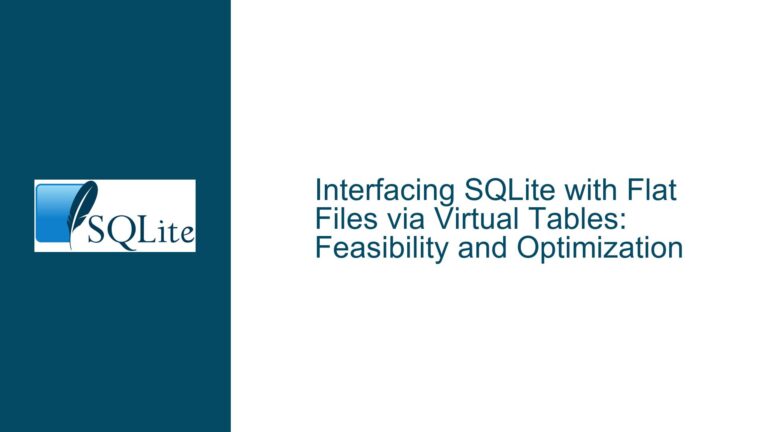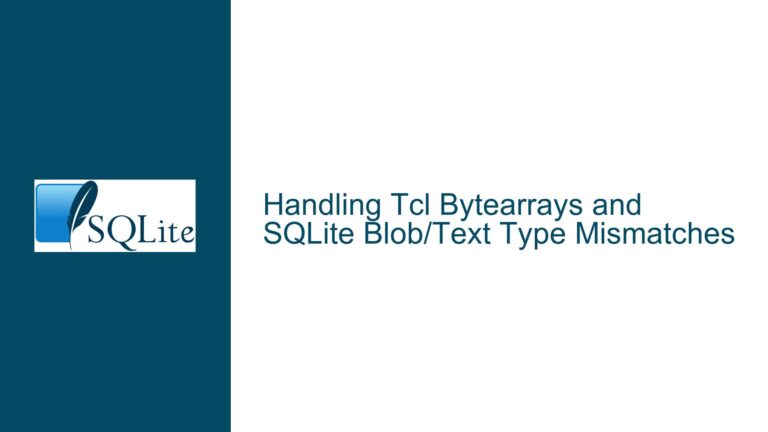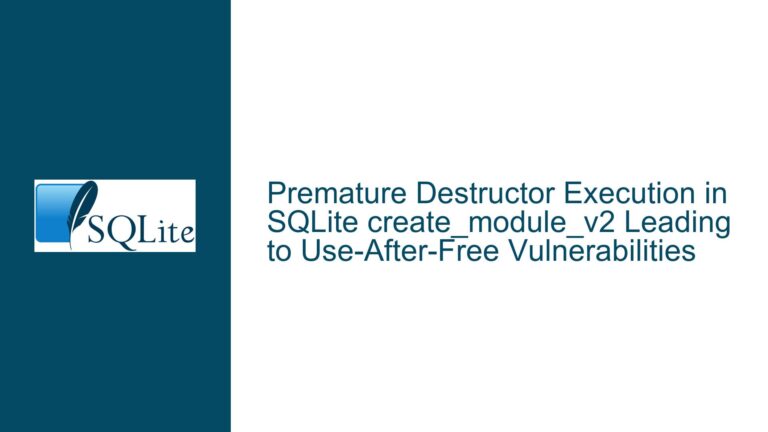Data Race Risk in SQLite’s unixTempFileDir Lazy Initialization
Concurrency Hazard in unixTempFileDir’s azDirs Initialization
The unixTempFileDir function in SQLite’s Unix-specific operating system interface (os_unix.c) is responsible for determining the directory where temporary files are stored. This function employs lazy initialization of the azDirs array, a static list of candidate directories for temporary file storage. The array is populated at runtime based on environment variables (SQLITE_TMPDIR, TMPDIR), filesystem paths (/var/tmp, /usr/tmp, /tmp), and process-specific subdirectories.
The critical issue arises during the first invocation of unixTempFileDir, where the first two elements of azDirs (indexes 0 and 1) are dynamically initialized. These elements store the directory paths derived from environment variables or fallback system paths. However, the initialization logic lacks thread synchronization mechanisms, such as a mutex lock, to protect concurrent write access to these shared memory locations. When multiple threads within the same process call unixTempFileDir simultaneously—typically during the creation of separate database connections—the unsynchronized writes to azDirs[0] and azDirs[1] can result in a data race.
A data race occurs when two or more threads access the same memory location without proper synchronization, and at least one access is a write. In this scenario, concurrent writes to azDirs could lead to memory corruption, invalid pointer dereferencing, or inconsistent directory path assignments. For example, one thread might overwrite the azDirs[0] value while another thread is still processing it, causing the latter to use an incorrect or partially written directory path. This risk is particularly pronounced in environments where SQLite is compiled with 64-bit pointer support but runs on 32-bit hardware architectures, as pointer operations may not be atomic under such configurations.
The hazard is latent under normal operation because most applications initialize temporary directories once during startup. However, in highly concurrent systems—especially those using connection pools or parallel query execution—the race condition becomes a tangible threat. The Go programming language’s runtime, which emphasizes lightweight goroutines and parallel execution, exacerbates this risk, as evidenced by the original bug report involving a Go-transpiled SQLite library.
Factors Enabling Race Conditions During Temporary Directory Selection
The root cause of the data race lies in the absence of thread synchronization around the initialization of azDirs. However, several preconditions must align for this race to manifest as a tangible defect:
Multi-Threaded Execution: The SQLite library must be operating in a multi-threaded mode (SQLITE_THREADSAFE=1 or 2). If SQLite is compiled with SQLITE_THREADSAFE=0, the library disables all threading primitives, rendering this issue moot.
First-Time Initialization Contention: The race occurs only during the first invocation of unixTempFileDir across all threads. Subsequent calls read from the already-initialized azDirs array, which is safe as long as the initial writes are atomic and complete before reads.
Non-Atomic Pointer Writes on 32-Bit Systems: On 32-bit machines, 64-bit pointer assignments (common in systems with 64-bit address spaces) may require multiple CPU instructions to complete. If a thread switch occurs mid-write, another thread could observe a partially updated pointer, leading to segmentation faults or incorrect directory resolution.
Environment-Dependent Directory Paths: The race affects systems where temporary directories are determined dynamically via environment variables (e.g., SQLITE_TMPDIR). If the directory paths are hardcoded or preconfigured at compile time, the initialization phase is bypassed.
Concurrent Database Connections: Each new database connection typically invokes unixTempFileDir to resolve its temporary directory. Applications that rapidly spawn multiple connections in parallel—such as web servers handling simultaneous requests—are at higher risk.
The interplay of these factors creates a narrow but critical window for race conditions. SQLite’s thread safety model generally relies on higher-level synchronization (e.g., application-managed mutexes around database handles). However, unixTempFileDir’s static storage duration and lack of internal locking violate this model, introducing a low-level concurrency flaw.
Mitigating Thread Contention in SQLite’s Unix-Specific Temp File Handling
Step 1: Validate SQLite Version and Patch Status
The SQLite development team addressed this race condition in commit 95806ac1dabe4598. To determine if your SQLite build includes this fix:
- Check the source code for the presence of a sqlite3_mutex guard around the azDirs initialization block in unixTempFileDir.
- If using an amalgamation build, verify the version identifier (SQLITE_VERSION_NUMBER) against the release timeline. Versions after 2021-11-19 include the fix.
Step 2: Apply the Official Patch
If your SQLite version is unpatched, modify os_unix.c as follows:
static const char *unixTempFileDir(void){
static const char *azDirs[] = {
0, /* 0: SQLITE_TMPDIR from environment */
0, /* 1: TMPDIR from environment */
"/var/tmp",
"/usr/tmp",
"/tmp",
".",
};
unsigned int i;
const char *zDir = 0;
/* Add mutex to protect azDirs[0] and azDirs[1] initialization */
sqlite3_mutex *mutex = sqlite3MutexAlloc(SQLITE_MUTEX_STATIC_TEMPDIR);
sqlite3_mutex_enter(mutex);
for(i=0; i<sizeof(azDirs)/sizeof(azDirs[0]); i++){
if( i>=2 ) zDir = azDirs[i];
if( i==0 ) zDir = sqlite3_uri_parameter(0, "temp_store_directory");
if( zDir==0 ) zDir = getenv("SQLITE_TMPDIR");
if( zDir==0 && i==1 ) zDir = getenv("TMPDIR");
if( zDir ) break;
}
if( zDir==0 ) zDir = ".";
azDirs[0] = zDir;
azDirs[1] = zDir;
sqlite3_mutex_leave(mutex);
return zDir;
}
This patch wraps the initialization logic with SQLITE_MUTEX_STATIC_TEMPDIR, ensuring atomic updates to azDirs.
Step 3: Enforce Thread-Safe Configuration
Ensure SQLite is compiled with thread safety enabled:
./configure --enable-threadsafe
Verify at runtime using sqlite3_threadsafe(), which should return 1 (serialized mode) or 2 (multi-thread mode).
Step 4: Preinitialize Temporary Directories
To eliminate runtime contention, predefine the temporary directory via environment variables before spawning threads:
setenv("SQLITE_TMPDIR", "/custom/tmp", 1);
This forces azDirs[0] to be initialized during process startup, avoiding concurrent writes later.
Step 5: Isolate Temporary Directories Per Connection
Assign unique temporary directories to each database connection using the temp_store_directory URI parameter:
ATTACH 'file:aux.db?temp_store_directory=/app/tmp/conn1' AS aux;
This bypasses the global azDirs resolution entirely.
Step 6: Monitor for Residual Contention
Even with the patch, audit application logs for I/O errors or unexpected temporary file locations. Tools like ThreadSanitizer (TSan) can detect residual data races:
clang -fsanitize=thread -lsqlite3 app.c
Step 7: Consider Alternative Temp File Strategies
For mission-critical systems, replace SQLite’s temp file handling with application-managed directories or in-memory databases (:memory:).
By systematically addressing the synchronization gap in unixTempFileDir, validating build configurations, and leveraging SQLite’s environmental controls, developers can eradicate this concurrency hazard while preserving the library’s lightweight efficiency.






